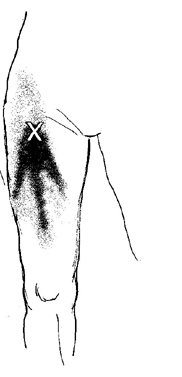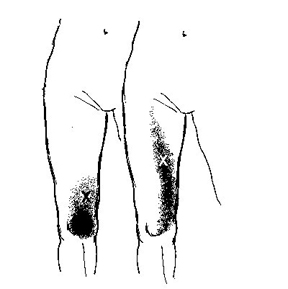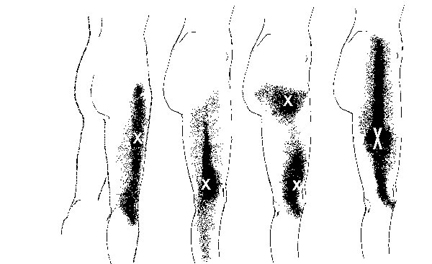Pain Pattern
(click on image to enlarge)
|
Muscle Name and Pain Pattern Description
|

|
Rectus femoris: pain refers to the front and middle of
knee and middle of knee/kneecap, especially on walking
downhill.
This is the longest of the quadricep muscles, running "straight"
down the "femur" (thigh).
Because it crosses two joints (both knee and hip, the only quad
to do so) it is rarely fully stretched; a trigger point is commonly
found an inch or so below its attachment at the anterior superior iliac spine).
Test and
treat rectus femoris.
|

|
Vastus intermedius:
pain radiates to the upper thigh especially when walking
up stairs or uphill. It can also cause difficulty in straightening the
leg after prolonged sitting or driving.
Vastus intermedius is often overlooked in treatment because
it lies beneath the larger rectus femoris muscle.
Test and
treat vastus intermedius.
|

|
Vastus medialis: pain on the medial (inner) side of
knee and kneecap.
Vastus medialis is the muscle behind "buckling knee" and the second
most common muscle in "growing pains" of the legs in children.
Test and treat vastus medialis..
|

|
Vastus lateralis: pain on lateral (outer) side of knee
sometimes as far down as the calf and as high as the crest of
the hip. Responsible for the feeling that the kneecap
isn't working quite right.
Vastus lateralis is the 800-pound gorilla of knee pain, the Number
One cause of "growing pains" in children's legs, and just as
painful in adults. A tight vastus lateralis can pull the kneecap
awry, locking the knee. This is often interpreted as "weakness" of
the medialis muscle, common in adolescent girls and blamed on failure
of the muscle to keep up with widening hip bones. Coincidentally, this
is about the time that girls start worrying about thin thighs and
working out on thigh machines. If not stretched afterwards, the muscle
will tighten and weaken.
Test and treat vastus lateralis.
|



